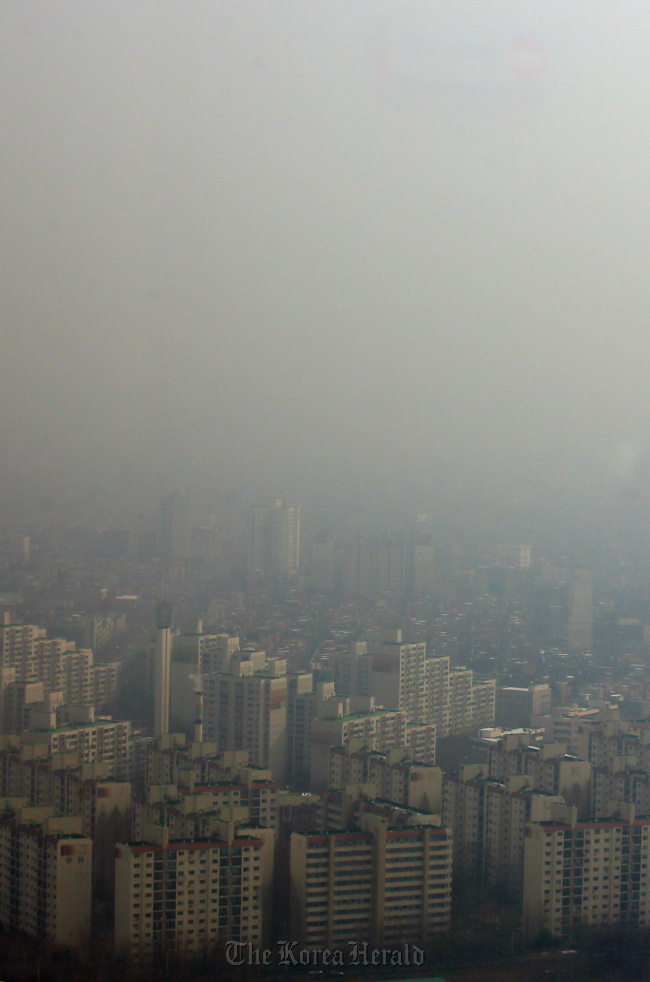Fine particles a stealthy killer
2013-01-24 20:31
On a murky morning last week, a group of environmental activists wearing face masks and red coveralls gathered at the Chinese Embassy in Seoul.“Beijing smog kills people,” they chanted, calling for measures to tighten pollution control and prevent the inflow of smog from Beijing.
A thick brown haze blanketed Seoul and other major cities across the country during the week, promoting environmental groups to step up calls for a swift implementation of standards to regulate the density of extremely small particles in the air.
 |
| A residential area in Seoul is covered with thick smog on Jan 15. (Yonhap News) |

Seoul City government data obtained by The Korea Herald shows that the levels of fine particles were well above World Health Organization’s 24-hour standard of 25 micrograms per cubic meter for five days.
The level of PM2.5 (particulate matter or fine particles smaller than 2.5 micrometers in diameter) was 59 micrograms per cubic meter on Jan. 12, then 83, 67, 70 and 57 micrograms on the consecutive days thereafter.
The levels could vary depending on what measures are used. A survey of air quality during the same period by the National Institute of Environmental Research shows even worse results. The daily levels of PM2.5 hovered above 100. The highest density of fine particles was 138 on Jan. 13 and the highest hourly level was 171 at 4 p.m.
Once particle pollution is inhaled, toxins can get into the lungs and even the bloodstream to cause respiratory diseases, heart attacks and various diseases which could shorten the lives of many: fine particles could infiltrate more deeply and stay longer than coarse particles in the lungs.
Particulate matter, or PM, is a mixture of small particles and liquid droplets which are made up of a number of components such as nitrates, sulfates, metals and dust particles.
Particle pollution can be grouped into two categories. Particles that are 2.5 micrometers and smaller in diameter are called fine particles or PM2.5, while those with a diameter larger than 2.5 micrometers and smaller than 10 micrometers are called coarse dust particles or PM 10.
A fine particle is about 30 times smaller than a single hair which is about 70 micrometers in diameter. Those particles come from vehicles, power plants, forest fires, unpaved roads, and construction sites.
The recent dense smog in Seoul coincided with the worst smog that choked Beijing with around 300 to 900 micrograms per cubic meter of PM2.5 in the air.
It is still controversial whether the smog in Seoul is mainly due to the pollutants coming from China.
“It has more to do with polluting materials emitted from cars and factories than pollutants blowing in from China,” said an official from the Korea Meteorological Administration, adding the simultaneous occurrence of smog in Beijing and Seoul is because the regions were under the influence of the same high pressure, which made the air stagnant.
However, joint research by Anyang University and University of Suwon in 2011 on PM2.5 showed that around 40 percent of the detected fine particles in Seoul blew in from China.
The Seoul city government and the Ministry of Environment said the recent smog in Seoul was caused to a great extent by the gray smog in China.
The Korean government plans to implement standards to regulate fine particles in 2015 around the capital Seoul and its surrounding areas.
According to the plans, the government will introduce an annual standard of fine particles at less than 25 micrograms per cubic meter, and a daily standard of less than 50 micrograms per cubic meter.
The standard, however, is less strict than the ones for the U.S and the World Health Organization.
Late last year, the United States set a new annual fine particle standard of 12 micrograms per cubic meter and a daily standard of 35 micrograms per cubic meter.
The WHO sets its annual standard at 10, and the 24-hour standard at 25.
The Seoul city government pledged to keep a close eye on the PM2.5 level and inform citizens while making other efforts to reduce the pollutants in the air including installing pollution control systems in cars running on diesel, and heating systems in buildings and households that emit low levels of nitrogen oxides.
“By 2015, the city government will try to reduce the level of particle pollution to below the standard level,” said Lim Ok-ki, chief at Seoul City government’s Climate and Environment Headquarters.
Civic groups called on the government to work together on the pollution issue with the neighboring countries, insisting that efforts to clean the air will come to no avail without cooperation.
“The government should discuss the issue with other Asian countries as well since they are feverishly trying to achieve industrial and economic development first before environment protection,” said Choi Jun-ho, director of civic environment group Friends of the Earth Korea.
By Kim Young-won (wone0102@heraldcorp.com)


